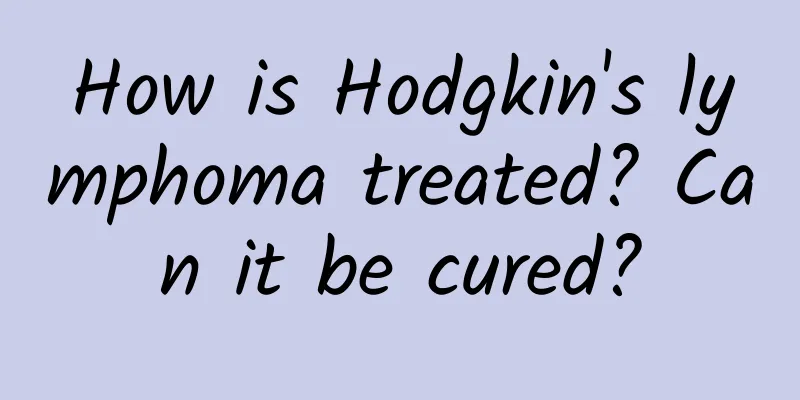How is Hodgkin's lymphoma treated? Can it be cured?

|
Author: Zhu Jun, Chief Physician, Peking University Cancer Hospital Reviewer: Wang Lixiang, Chief Physician, Third Medical Center, PLA General Hospital The 10th Chairman of the Science Popularization Branch of the Chinese Medical Association Hodgkin's lymphoma, also known as Hodgkin's disease, is one of the most common malignant tumors among young people. Once diagnosed, it must be treated actively. Before treatment, Hodgkin lymphoma often needs to be staged. According to the distribution and size of lymphoma in the patient's body, it can be divided into four stages, namely stage I, stage II, stage III, and stage IV. Stage I is the early stage, stage IV is the late stage, and stage II-III is the middle or middle-late stage. In addition to staging, an overall assessment of the patient is also required to understand the patient's physical condition and clarify the functions of the patient's blood, heart, liver, lungs, kidneys, etc., so that an appropriate treatment plan can be formulated. For patients with Hodgkin lymphoma, whether it is stage I or stage IV, the treatment plan is similar, and the same standard chemotherapy regimen, ABVD, may be used, which is the most commonly used regimen. A is doxorubicin, an anthracycline; B is bleomycin; V is a neoadjuvant drug, vincristine or vindesine; D is dacarbazine. Figure 1 Original copyright image, no permission to reprint However, the duration of use may vary from patient to patient. For example, patients in stage I-II can finish the battle with 3-4 cycles, but patients in stage III-IV generally need 4-6 cycles or 6-8 cycles. Of course, some people have made some minor adjustments to the composition of this chemotherapy regimen. For patients with very early and mild disease, one or two drugs can be removed to reduce the toxic and side effects of chemotherapy. However, this approach has not been widely recognized by peers around the world and is only being tried in trials. ABVD is still considered the most standard regimen. If the treatment effect of ABVD is not good, a second-line chemotherapy regimen or a third-line chemotherapy regimen should be selected. The more commonly used regimens now include BEACOPP regimen, DICE regimen, ICE regimen, GEMOX regimen containing gemcitabine, etc. Another method that deserves special attention is hematopoietic stem cell transplantation, or autologous hematopoietic stem cell transplantation. Because after about 40 years of experience, even for patients who have relapsed and progressed after poor response to first-line treatment or treatment failure, more than half of these patients can be cured through autologous hematopoietic stem cell transplantation. Figure 2 Original copyright image, no permission to reprint For example, for patients who have failed ABVD treatment and have relapsed or progressed, the second-line DICE regimen is used. This regimen can control the relapsed or progressed lesions, and the efficacy is good. If PR (partial remission) or CR (complete remission) is achieved, hematopoietic stem cells can be collected. What does it mean to collect hematopoietic stem cells? It means collecting hematopoietic stem cells from peripheral blood through a special machine. The collected amount may be only 40 ml, 50 ml or 80 ml, but it is rich in hematopoietic stem cells. It can be understood that the seeds of hematopoiesis are stored in the "bank". Then, at a chosen time, a high-dose chemotherapy is performed in a sterile chamber. This high-dose chemotherapy almost suppresses the body's bone marrow and basically eliminates white blood cells and platelets. Then the stored hematopoietic seeds are transfused back. After the transfusion, we must pay attention to taking good care of the patient to avoid infection and other unexpected situations. Wait until these seeds grow and bloom, and grow more and more new cells, which is called hematopoietic reconstitution and hematopoietic recovery, and the process of autologous hematopoietic stem cell transplantation is completed. After the autologous hematopoietic stem cell transplantation, the patient should lead a normal life, undergo observation and follow-up. The patient should be reexamined every three months in the first one or two years after the transplantation. If there is no recurrence in one or two years, the patient can be reexamined every six months, and then once a year thereafter. At present, the cure rate of Hodgkin's lymphoma is very high. For example, in the lymphoma department of Peking University Cancer Hospital, among the Hodgkin's lymphoma patients who have been hospitalized for nearly 40 years, the cure rate or five-year survival rate has exceeded 80%, which is close to the best level in the world. The treatment of Hodgkin's lymphoma is a combination of basic chemotherapy and radiotherapy. Now, more and more attention is paid to new immune targeted therapy methods. For example, CD30 monoclonal antibody has been approved for the treatment of relapsed and refractory Hodgkin's lymphoma, bringing greater hope of cure to Hodgkin's lymphoma patients. |
<<: What are the symptoms of Hodgkin lymphoma? How is it diagnosed?
>>: Say goodbye to the trouble of mid-infiltration, anti-VEGF drug treatment helps restore vision
Recommend
Will bad stomach delay menstruation?
In life, many people have poor gastrointestinal c...
Women have no blood when they urinate but have blood when they wipe
Is it a worrying phenomenon if there is no blood ...
Just by "drinking" a cup of "milk tea", patients with stomach problems such as cerebral infarction can also have a stomach check!
Gastric disease is one of the common problems tha...
Comb milk knot
Simply put, the milk clotting phenomenon means th...
Can I exercise to lose weight during menstruation?
Loving beauty is a woman's nature. In today&#...
Symptoms of spleen and stomach deficiency and dampness in women
In daily life, many people suffer from some abnor...
If your stomach is growling, it may not be because you are hungry. Be careful of these 4 situations!
In movies, TV shows or literary works, the rumbli...
What are the methods for women to nourish the kidneys?
Generally speaking, when people talk about kidney...
Pregnant woman becomes ugly, is it a boy or a girl?
Most pregnant mothers would like to know whether ...
Can I have a natural birth after laser surgery on my cervix?
Nowadays, many female friends have some gynecolog...
Abnormal vaginal microecological flora
The female urinary system is a very sophisticated...
How to promote the secretion of female hormones
The secretion of estrogen is very important for w...
Girl fainted due to low blood sugar
I believe that many people have experienced or se...
What to do if you bleed during non-menstrual period
If you find that you have vaginal bleeding during...
Pelvic repair procedure steps
After ten months of creation and childbirth, the ...









